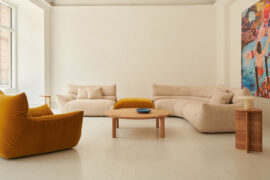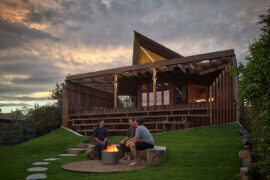Is the mindset of designing for convenience destroying the human body? Commercial furniture makers, Wilkhahn dissect the problems of modern office culture, and propose how design can take a commanding role in causing a much-needed seismic shift. Sophia Watson writes.

July 14th, 2015
From a biological perspective, we humans are still hunters and gatherers, driven by our instincts and our “natural blueprint”. Our bodies are designed to move, especially to walk; and here, the culture of modern offices and its underlying emphasis on “convenience” is killing us.
Burkhard Remmers, international communication director from commercial furniture studio, Wilkhahn, explains that current commercial culture – and the way designers think about the functionality of space – is ultimately “reducing strain on our bodies, where office work has become a kind of a comatose inactivity.”
Here Remmers notes that: “Unfortunately, most organisational concepts are still focused on reducing movement and keeping routes we take to get from A to B short. We should ask if these ideas of organisation in general really still fit the skills needed in a knowledge-based economy, especially in office environments.”
Generally speaking, you would think that designing for convenience would cut the proverbial fat of say, walking unnecessary lengths to the printer, getting to the elevator quickly from any vantage point or not having to walk to the other end of the office to follow up with a colleague; all of which should reduce time-wasting and presumably increase productivity, right? And to some extent, it works. But designing for convenience has created some dangerous side effects including: metabolic disorders, cardiac and circulatory problems, headaches, muscular and skeletal complications, issues with digestion, diabetes, obesity and even cancer and depression related mental illness.
A number of design houses are already jumping on this call to action; no doubt you’ve heard the recent adage that ‘sitting is the new smoking’ – to which Remmers responds that: “It is a remarkable statement, but also much too simplistic. This is a challenge for our understanding of ergonomics, of organisational and architectural concepts and of our culture.”
While some are only beginning to cotton on to the role design can play in improving the human condition within commercial settings, Wilkhahn has devoted decades to making people less desk-bound and invested a great amount of time and research into this area as early as the 1970s.
“Back in the seventies, designer Nick Roericht – who was a student and later a teacher at the legendary Ulm University of Design – carried out a major study for Wilkhahn entitled ‘From a posture-driven to a movement-driven seat’. His radical concept of a leaning aid instead of a chair later became part of the Wilkhahn range (Stitz 2). But the results also led to the groundbreaking FS-Line office chair and allowed the principle of dynamic sitting to gain widespread acceptance. In 2005, we gave a critical rethink to the development of chair ergonomics using original research from medical sports and science. The results confirmed that two-dimensional movements are not sufficient to stimulate the complex interrelations of our body. The challenge became ‘to teach sitting to walk’.”
In response to the problems created by the modern “convenient” office, and after five years’ in development, Wilkhahn, launched the ON chair. This was the first chair with patented Trimension, a new kinematical principle stimulating natural three-dimensional movements. It stimulates and activates the body without tiring or overtaxing it.
In a more recent move to contribute to getting people to move more, Wilkhahn is soon to launch its latest innovation, the IN chair. Also developed off the back of some serious R+D, specifically the ‘From a posture-driven to a movement-driven seat’ study, the IN chair continues teaching sitting to walk. “After years of exhaustive research and development,” says Remmers, “we came up with a patented world first called Trimension®. This is a new international standard that was used for the first time in our ON® office chair. Now our engineers have succeeded in adapting this pioneering kinematics for an office chair in the mid-range price segment. The launch of IN 3D chair heralds an office chair that ensures previously unparalleled sitting dynamics, follows the body in perfect synchronisation and keeps its centre of gravity whatever the posture. This doesn‘t just benefit our health, but also increases powers of concentration and our ability to relax.”
It should be achingly clear by now that design, as an industry, needs to start looking at how to positively impact on human behavior – and product alone isn’t enough. Companies such as Wilkhahn are trail-blazing this sector by focusing on solving problems ‘with’ product, investing in intensive, science-based R+D to inform their output, rather than product alone and the colours it comes in. And that is the critical difference.
Wilkhahn
wilkhahn.com
INDESIGN is on instagram
Follow @indesignlive
A searchable and comprehensive guide for specifying leading products and their suppliers
Keep up to date with the latest and greatest from our industry BFF's!

Rising above the new Sydney Metro Gadigal Station on Pitt Street, Investa’s Parkline Place is redefining the office property aesthetic.

A curated exhibition in Frederiksstaden captures the spirit of Australian design

In Australia alone, 6.4 per cent of all waste generated comes from furniture and furnishings. In this article, we review today’s most impactful Whole Of Lifecycle Furniture practices.

Globally recognised environmental pioneers Wilkhahn are once again taking bold strides forward in the name of sustainability. The award-winning Yonda collection is their magnum opus of design circularity.
The internet never sleeps! Here's the stuff you might have missed

Sydney Open invites the public to explore over 55 buildings, spaces and new additions to the skyline, with a newly released Talks & Tours program offering direct access to the architects behind Bundarra and Pier Pavilion.

Recognised as a winner at the INDE.Awards 2025, Barton Taylor has received The Photographer – Residential accolade. His photographic work on Cake House captures the soul of a coastal icon reimagined, blending light, texture and atmosphere into a compelling visual narrative.